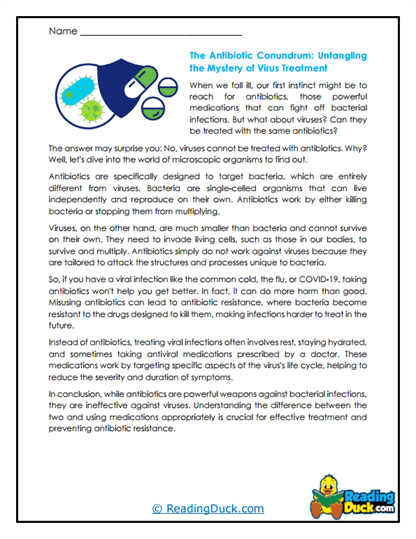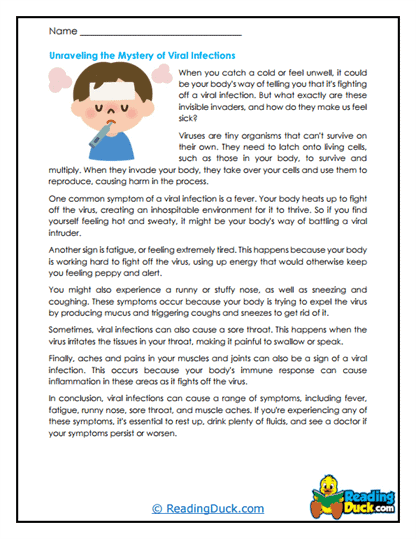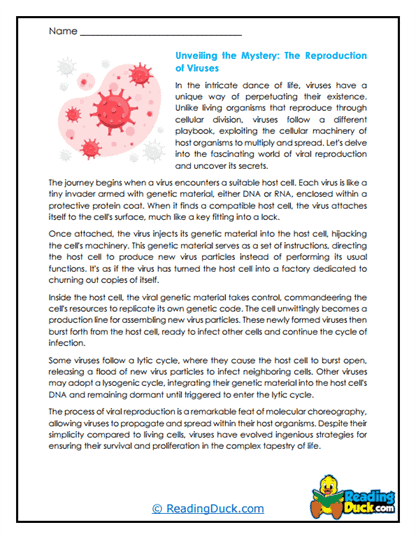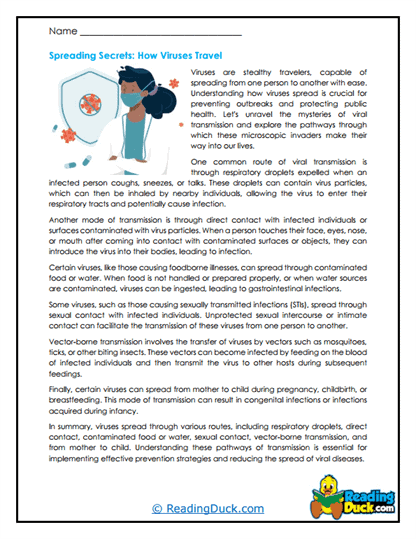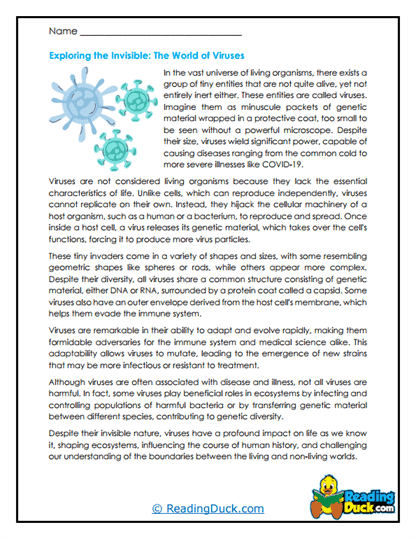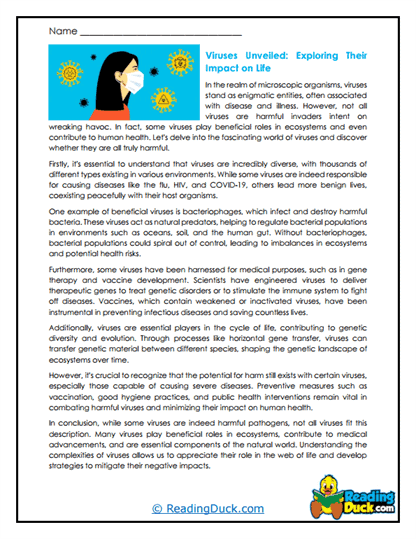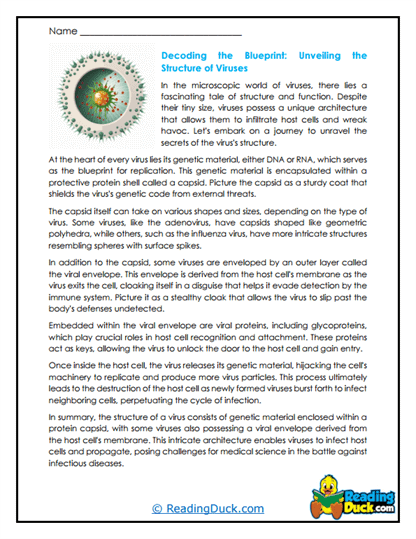Viruses Worksheets
About Our Viruses Worksheets
Our Viruses Worksheets provide an engaging and comprehensive introduction to the fascinating world of viruses—microscopic agents that can only replicate within the living cells of a host organism. As a further subtopic within the fields of Biology and Microbiology, this collection delves into the structure, classification, life cycles, and impacts of viruses on both human health and the environment. These worksheets are designed to make the study of viruses both educational and captivating, helping students build a solid foundation in understanding these complex entities.
This collection contains several worksheet sets, each focusing on different aspects of viruses. Each worksheet set includes:
- Multiple Choice Questions: These questions assess students' comprehension of the reading material, ensuring they grasp the key concepts and details presented.
- Short Answer Questions: This section encourages students to articulate their understanding in their own words, reinforcing their knowledge and improving their ability to communicate scientific information effectively.
- Open-Ended Questions: These questions invite students to share their personal thoughts, opinions, and reflections on the material, fostering deeper engagement and critical thinking.
An answer key is provided for every question sheet, making it easy for educators and parents to review students' work. All worksheets are available in PDF format, allowing them to be easily viewed electronically, downloaded, and printed for use in various educational settings.
Understanding Viruses: The Intriguing World of Infectious Agents
Viruses are unique among microorganisms because they occupy a gray area between living and non-living entities. They are not considered alive because they cannot carry out metabolic processes or reproduce independently. Instead, they must hijack a host's cellular machinery to replicate. Introducing students to viruses involves discussing their structure, how they infect hosts, the diseases they cause, and the broader implications of viral infections on public health. Here’s a detailed breakdown of the key aspects of viruses covered in this collection:
Structure and Classification of Viruses: Viruses are incredibly diverse, and understanding their structure is crucial to understanding how they function.
- Viral Structure: Students will explore the basic structure of a virus, which typically includes a nucleic acid core (either DNA or RNA) surrounded by a protein coat called a capsid. Some viruses also have an outer lipid envelope derived from the host cell membrane. Understanding these components helps students grasp how viruses protect their genetic material and how they recognize and enter host cells.
- Classification of Viruses: Viruses are classified based on their genetic material, morphology, and the types of organisms they infect. Students will learn about the major viral families, including retroviruses, adenoviruses, and bacteriophages, and how this classification helps scientists understand the relationships between different viruses and their evolutionary origins.
Life Cycle of Viruses: The viral life cycle is a critical aspect of understanding how viruses replicate and spread.
- Attachment and Entry: The first step in the viral life cycle is the attachment of the virus to a specific receptor on the host cell, followed by the entry of the viral genome into the cell. Students will learn how different viruses use different strategies to gain entry into host cells, such as fusion with the cell membrane or endocytosis.
- Replication and Assembly: Once inside the host cell, the virus uses the cell's machinery to replicate its genome and produce viral proteins. These components are then assembled into new viral particles. Students will explore how this process can vary depending on whether the virus has a DNA or RNA genome.
- Release and Spread: The final step in the viral life cycle is the release of new viral particles from the host cell, often leading to cell death. Students will learn about the different mechanisms viruses use to exit cells, such as budding or lysis, and how this contributes to the spread of the virus within the host organism and to other hosts.
Impact of Viruses on Health and Society: Viruses are responsible for a wide range of diseases, from the common cold to more severe illnesses like HIV/AIDS and COVID-19.
- Viral Diseases: Students will explore the symptoms, transmission, and treatment of various viral diseases, such as influenza, hepatitis, and the human papillomavirus (HPV). Understanding these diseases helps students grasp the real-world implications of viral infections and the importance of public health measures.
- Vaccination and Immunity: Vaccines are one of the most effective tools for preventing viral infections. Students will learn how vaccines work by stimulating the immune system to recognize and fight specific viruses, and they will discuss the role of herd immunity in protecting populations from outbreaks.
- Antiviral Treatments: Unlike bacterial infections, which can often be treated with antibiotics, viral infections are more challenging to treat. Students will explore the different types of antiviral drugs, such as those used to treat HIV or influenza, and the challenges in developing effective treatments for emerging viral diseases.
Viruses and Biotechnology: Beyond their role in disease, viruses also have applications in research and biotechnology.
- Gene Therapy: Viruses are used in gene therapy to deliver therapeutic genes into patients' cells. Students will explore how modified viruses can be used to treat genetic disorders by replacing faulty genes with functional ones.
- Vaccination Development: The development of viral vectors for vaccines, such as the use of adenoviruses in COVID-19 vaccines, showcases the innovative ways scientists use viruses for the benefit of human health. Students will learn about the process of vaccine development and the role of viruses in creating safe and effective vaccines.
- Research Tools: Viruses are used as tools in molecular biology to study gene function and regulation. Students will explore how bacteriophages and other viruses have been instrumental in advancing our understanding of genetics and cell biology.
By studying these aspects of viruses, students gain a comprehensive understanding of how these microorganisms function, how they interact with host organisms, and the impact they have on human health and society. The worksheets help break down complex concepts into engaging and accessible material, fostering curiosity and a deeper appreciation for the role of viruses in both science and everyday life.
How to Supplement These Worksheets
Here are four creative ideas on how teachers and parents can use these Viruses Worksheets in school or in a homeschool setup:
- Viral Structure Models: Encourage students to create 3D models of viruses using craft materials. They can build models of different viruses, such as influenza or HIV, to better understand their structure and how they interact with host cells. This hands-on activity reinforces the concepts of viral morphology and classification.
- Case Studies of Viral Outbreaks: Assign students to research a historical or contemporary viral outbreak, such as the Spanish flu of 1918, the Ebola outbreak, or the COVID-19 pandemic. Using the worksheets as a guide, students can explore the virus involved, the spread of the disease, the public health response, and the impact on society. This project enhances research skills and helps students understand the broader implications of viral infections.
- Simulating Viral Spread: Conduct a classroom activity to simulate how viruses spread within a population. You can use simple materials like stickers or colored dots to represent viral particles and demonstrate how quickly an infection can spread in a group setting. This activity helps students grasp the importance of measures like vaccination, quarantine, and social distancing in controlling outbreaks.
- Debate on Viral Research Ethics: Organize a classroom debate on the ethical considerations of viral research, such as the use of viruses in gene therapy, vaccine development, or gain-of-function studies. Students can use the worksheets to prepare their arguments, considering both the potential benefits and risks of viral research. This activity encourages critical thinking and ethical reasoning.
The Importance of Learning About Viruses
Understanding viruses is crucial for students on both an academic and personal level. Academically, it provides a foundation for advanced studies in biology, microbiology, medicine, and public health. It also enhances critical thinking skills as students explore the complexities of viral structure, life cycles, and the challenges in controlling viral diseases.
On a personal level, knowledge of viruses empowers students to make informed decisions about their health and the health of others. Understanding how viruses spread, the importance of vaccination, and the risks associated with certain behaviors helps students take an active role in preventing infections. This awareness can lead to healthier lifestyle choices and a better understanding of how to protect themselves and their communities from viral diseases.
Overall, these Viruses Worksheets offer a valuable resource for educators and students alike, providing a detailed and engaging exploration of one of the most important topics in microbiology. Through these activities, students can deepen their understanding of viruses and develop a greater appreciation for the intricate balance between pathogens and human health.
